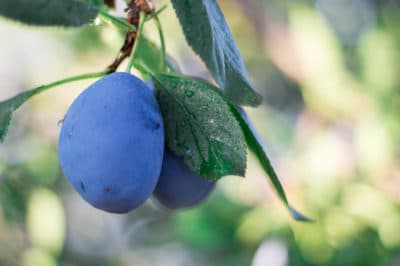What Plum Leaves Look Like
Plum tree leaves are broadly oblong to slightly lance shaped, depending on the variety. Leaves have the distinguishing characteristic of small serrations along the leaf margin and pointed leaf-tips.
The many species and cultivars of plums have a range of leaf and fruit colors. Leaves range from bright-green to dark-green, and many hybrid varieties have purple or red leaves throughout the growing season. Ripe fruit can be purple, red, green, or yellow.
Purple Leaf Varieties of Plums
Many purple leaf varieties of plums belong to the species Prunus cerasifera, also known as purple-leaf plum, cherry plum, and Myrobalan plum. These plums can grow to become medium-sized trees, and they are covered with showy, fragrant flowers early in the season, making them an attractive ornamental.
Prunus casasifera also produces small fruits which can be purple, yellow, or red in color, which are enjoyed by people, birds, and other wildlife. If you grow this species as an ornamental, be prepared to clean up fallen fruit at the end of the season.
Purple leaf varieties of plums have about a 20-year lifespan, and grow well in planting zones 4 to 9. Like other plum trees, they prefer full-sun and slightly acidic, well-draining soil. Prune out dead, diseased, and damaged wood after flowering to avoid injuring blossoms.
Problems with Plum Leaves
When plum tree leaves don’t look right, they are telling you something about the health of the tree. Problems showing themselves in the leaves include:
- Lack of water: While plum trees can tolerate some drought, they grow best with regular, deep watering during warm weather. Serious lack of water can cause leaves to fall off of the tree.
- Disease problems: Shot hole disease, plum leaf spot, and bacterial leaf spot are pathogens which cause leaves to drop from plum trees.
- Insect infestations: Spider mites, aphids, and plum curculio beetles are plum tree pests which damage to the leaves.
- Nutrient and pH problems: An imbalance in nitrogen or micronutrients like sulfur, iron, boron, and manganese can cause leaves on plum trees to change color or fall off.
- Sunlight conditions: Purple leaf varieties of plum may develop green leaves if they are planted in too much shade.
- Phototoxicity: Spraying with horticultural oils or insecticidal soaps during temperatures over 80ºF (27ºC) can cause damage to the leaves.
Keeping leaves vigorous and healthy gives a plum tree the energy it needs to thrive.
